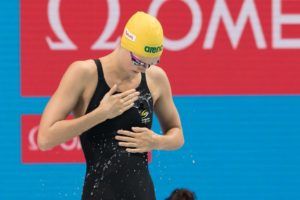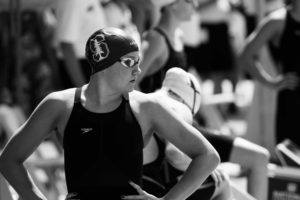2018 PAN PACIFIC CHAMPIONSHIPS
- Thursday, August 9 – Tuesday, August 14, 2018
- Tokyo Tatsumi International Swimming Center, Tokyo, Japan
- Event schedule
- Meet site
- Meet records
- Psych Sheet
Unlike the other three strokes, the podium of the women’s butterfly events will look entirely different from the 100 to the 200.
In the 100, expect to see the race come down to the wire between Rikako Ikee of Japan, Emma McKeon of Australia, and Kelsi Dahlia of the United States. If you spend enough time analyzing, it’s possible to spin this podium any number of possible combinations – that’s how close this race should be. Tied with World Record holder Sarah Sjostrom for the fastest time in the world this year (56.23), the nod has to go to Ikee in a home-country competition. The 18 year-old Olympic finalist has been incredibly consistent over the last several years and has a prime opportunity this weekend in Tokyo to set herself up for a run at Sjostrom heading into another home-country competition in two years – the 2020 Olympics in Tokyo. She placed 5th in the 2016 Rio Olympics (56.86) and 6th at the 2017 World Championships in Budapest (57.08).
Following closely behind is Dahlia and McKeon. Dahlia’s rise to the top of the sprint fly ranks has been steady over the past few years. At the 2016 Olympics, she finished 9th (57.54) – well off her then-best time of 56.48 and one spot away from the final. Although she should have made it in anyways as 4th place finisher Chen Xinyi of China tested positive for a banned substance and was subsequently banned from the Games. In 2017, Dahlia continued to climb – earning a bronze medal at Worlds with a lifetime best of 56.37. She has been floating around the 56-range for several years and is poised for a breakout performance – potentially creeping closer to Dana Vollmer‘s American Record time of 55.98.

Emma McKeon 2017 World Championships Budapest, Hungary (photo: Mike Lewis)
On merit alone, McKeon should be the favorite. She has the fastest lifetime best of the field with a 56.18 set last summer en route to a silver medal at Worlds. That time makes the Aussie the 4th fastest performer of all time behind Sjostrom (who owns the entire top 10 performances list), Vollmer, and China’s Liu Zige. The only question mark for the 24 year-old is: what does she have left in the tank this season? She claimed gold at the Commonwealth Games in April with a 56.78 (Games Record) and followed it up with a 56.61 at the Australian Pan Pac Trials in July. After recently announcing that she was dropping the individual 200 free from her Pan Pacs lineup, McKeon also mentioned that she even doubted whether or not she would compete at all in Tokyo by saying, “I wasn’t sure if I was going to do Pan Pacs because I wanted to focus on other things, like getting my shoulder right again and getting my strength back in the gym.”
In the 200, American Hali Flickinger finally had her breakthrough moment at the U.S. Nationals last month – smashing her personal best with a 2:05.87 and breaking Mary T. Meagher‘s U.S. Open Record of 2:05.96 that had stood since 1981. Before Nationals, Flickinger had been 2:06 once and 2:07/2:08 dozens of times. So, dropping that 2:05 had to arm her with confidence and set her on the trail of positive momentum heading into Pan Pacs. After Flickinger, Australia’s Laura Taylor comes in as a bit of a surprise. The 18 year-old won the Aussie Commonwealth Games Trials with a lifetime best of 2:06.80 – downing the likes of McKeon, Brianna Throssell, and Olympic silver medalist Maddie Groves. She wasn’t quite able to top that performance at the Games, though – finishing 2nd in a time of 2:07.39.

Katie Drabot (photo: Mike Lewis)
Even more of a surprise (to those outside of her circle, of course) than Taylor is American Katie Drabot. The 20 year-old was nowhere in the conversation for this event a year ago. Known primarily as a freestyler, she added the 200 fly to her repertoire during the NCAA short course season which resulted in a 2nd place at the NCAA Championships in March. Moving into the summer, Drabot’s best time in the LCM 200 fly was 2:25.72 (not a typo). She swam it once only in prelims of the Pro Swim Series in Indianapolis where she rattled off a 2:08.38 – making her a serious contender at Nationals. She secured her Pan Pacs roster spot in Irvine thanks to a swift 2:07.18, leaving her just outside of the all-time top 10 for American performers. Like Flickinger and Taylor, Drabot is riding a wave of momentum and will be dangerous in Tokyo.
Other challengers in this race could be American backstroke sensation Regan Smith (who swam a 2:07.42 at the U.S. Nationals but appears to have scratched this event at Pan Pacs) and the Aussie Groves. Groves, the 2016 Olympic silver medalist (2:04.88), had a rough 2017 that included contesting a potential suspension from competition due to missing 3 doping tests over a 12-month period and undergoing surgery for endometriosis. Japan’s Suzuka Hasegawa is seeded 2nd with a 2:06.00, but only has a season best of 2:08.69. She finished 6th last summer at the World Championships in Budapest with a 2:07.43.
MEDALIST PICKS
100 Fly
| Medal | Name | Nation | Season-Best | Lifetime-Best |
| Gold | Rikako Ikee | Japan | 56.23 | 56.23 |
| Silver | Kelsi Dahlia | USA | 56.83 | 56.37 |
| Bronze | Emma McKeon | Australia | 56.61 | 56.18 |
200 Fly
| Medal | Name | Nation | Season-Best | Lifetime-Best |
| Gold | Hali Flickinger | USA | 2:05.87 | 2:05.87 |
| Silver | Laura Taylor | Australia | 2:06.80 | 2:06.80 |
| Bronze | Katie Drabot | USA | 2:07.18 | 2:07.18 |
